|
|
Canku Ota |
|
|
(Many Paths) |
||
|
An Online Newsletter Celebrating Native America |
||
|
June 29, 2002 - Issue 64 |
||
|
|
||
|
The Meeting of the Wild Animals |
||
|
Tsimshian
|
||
|
credits: Wolverine
line drawing by Wayne Lewis
|
| A long time ago, when the Tsimshian
lived on the upper Skeena River in Prairie Town, they were the cleverest
and the strongest of all humans. They were good hunters and caught many
animals. They went hunting the whole year round, and all the animals feared
for their survival.
On the following day the large animals assembled on a wide prairie and called together all the small animals, even down to the insects. The multitude sat down, the small animals on one side of the plain, the large animals on the other. Panther came, and Black Bear, Wolf, Elk, Reindeer, and Wolverine.
The Panther said, "I fully support this wise counsel," and all the large animals agreed. Grizzly Bear turned to the small animals and said, "We want to know what you think of this matter."
Grizzly Bear rose again. "We need not pay attention to what Porcupine says, he told the large animals. "You all agree, don't you, that we should ask for the severest cold on earth?" The large animals replied, "Yes, we do. We don't care for Porcupine's reasoning." "Now, listen once more! I will ask you just one question," Porcupine said. "If it's that cold, the roots of all the wild berries will freeze and die, and all the plants of the prairie will wither away. How will you get food? You large animals roam the mountains wanting something to eat. When your request brings more winter frost, you will die of starvation in spring or summer. But they will survive, for they live on the bark of trees, the very small animals eat the gum of trees, and the smallest insects find their food in the earth." After he had spoken, Porcupine put his thumb into his mouth, bit it off, said, "Confound it!" and threw his thumb out of his mouth to show the large animals how bold he was. He sat down again, full of rage. Therefore the hand of the porcupine has only four fingers, no thumb.
Then Porcupine spoke again in his wisdom:
"In winter we will have ice and snow. In spring we will have showers,
and the plants will become green. In summer we will have warmer weather,
and all the fishes will go up the rivers. In the fall the leaves will
drop, it will rain, and the rivers and brooks will overflow. Then all
animals, large and small, and those that That's why wild animals, large and small, take to their dens in winter. Only Porcupine does not hide, but goes about visiting his neighbors. Porcupine also went to the animals that had slighted him at the meeting and struck them dead with the quills in his tail. That's why all the animals are afraid of Porcupine to this day. Print and Color Your Own Wolverine |
|
|
|
Wolverine (Gulo
gulo)
|
|
|
The Wolverine is a tremendous character….
a personality of unmeasured force, courage, and achievement so enveloped
in a mist of legend, superstition, idolatry, fear, and hatred, that
one scarcely knows how to begin or what to accept as fact. Picture a
weasel—and most of us can do that, for they have met that little
demon of destruction, that small atom of insensate courage, that symbol
of slaughter, sleeplessness, and tireless, incredible activity—picture
that scrap of demoniac fury, multiply that mite some fifty times, and
you have the likeness of a Wolverine.
--Ernest Thompson Seton, 1906
Some people call this animal Skunk Bear, Devil Bear, Devil Beast, or Glutton... but it is most commonly known as a Wolverine. It is in the order carnivora, in the family mustelidae (weasels, skunks), and is the sole member of the genus Mustelinae. Even though some people say it looks like a bear, it's not related to the bear at all. Wolverines are dark brown in color, with tan stripes down both sides, meeting at the shoulder and tail. Some people call these markings "Diamonds" because of the diamond like shape. They have long, fluffy tails. Females will may weigh up to 25 pounds. Males usually weigh up to 35 pounds. Occasionally a male will top 50 pounds, but it is very unusual. Although wolverines are relatively small animals, pound for pound they are considered to be one of the strongest mammals in the world... and they all have an extremely nasty disposition.
Wolverines live in the northern areas of Europe, Asia, and North America. Wolverines make snow caves for weather protection. These caves are usually dug into snow drifts and are not very long. Natal dens are prepared during late winter. The female wolverine experiences delayed implantation, having been bred the previous summer. The kits do not begin to grow inside her until mid winter. The den she prepares is long, maybe 30 feet long. Leaves and grasses make up the nest at the rear of the tunnel. The inside climate of the den is constant. Winds and temperatures will not affect the coziness of the den when the kits are born in March.
Their primary enemy is the wolf. When a wolf pack closes in on a wolverine the wolverine can't defend himself. Although wolves may attack and kill a wolverine they will rarely eat the carcass. Bears are a threat especially Brown and Polar have been reported to kill wolverines. Usually, however, a bear will not attack a wolverine unless there's a fight over food. Wolverine's are both predators and scavengers. Their main diet when food is plentiful is grouse, ptarmigan, snowshoe hares, voles, lemmings, and arctic ground squirrels. Sometimes they eat moose calves and caribou calves, marmot, mink, weasels, ermines, pika, and other small animals.
The trapper could be considered an enemy of the wolverine. Often trappers kill wolverines because they have found his trap line and eaten the trapper's bounty. Once a wolverine discovers a trap line it is a tempting and easily available source of food. The trappers don't appreciate having their valuable pelts snatched away, so they either have to give up their trap line or destroy the wolverine. It takes a heavy duty snap-trap to hold a wolverine. Wolverines are very cautious of traps. Sometimes the only way to capture the wolverine is by using a snare and enticing the wolverine into the snare with (good smelling) carrion. The wolverine's pelt is prized by many Native Americans and used for the ruff (collar). The wolverine fur doesn't frost over in the cold, so it protects the faces and ears of people outside in severe weather conditions. A major threat to the wolverine is the loss of habitat due to human invasion and activities. Road systems, snow machine activity, and other intrusions into the wolverine's territory force into other areas.
|
|
|
|
||
|
|
||
| Canku Ota is a free Newsletter celebrating Native America, its traditions and accomplishments . We do not provide subscriber or visitor names to anyone. Some articles presented in Canku Ota may contain copyright material. We have received appropriate permissions for republishing any articles. Material appearing here is distributed without profit or monetary gain to those who have expressed an interest. This is in accordance with Title 17 U.S.C. section 107. | ||
|
Canku Ota is a copyright © 2000, 2001, 2002 of Vicki Lockard and Paul Barry. |
||
 |
 |
|
|
The "Canku Ota - A Newsletter Celebrating Native America" web site and its design is the |
||
|
Copyright © 1999, 2000, 2001, 2002 of Paul C. Barry. |
||
|
All Rights Reserved. |
||
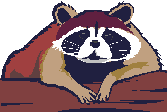 Grizzly
Bear invited all the large animals to his house. "A terrible calamity
has come to us with these hunting people, who pursue us even into our
dens," he said. "I suggest we ask Him Who Made Us to give
us more cold winter and keep the hunters in their own houses and out
of our dens!" All the large animals agreed, and Wolf said, "Let's
invite all the small animals -- Porcupine, Beaver, Raccoon, Marten,
Mink, and even the really small ones such as Mouse and the insects --
to join us and increase our strength."
Grizzly
Bear invited all the large animals to his house. "A terrible calamity
has come to us with these hunting people, who pursue us even into our
dens," he said. "I suggest we ask Him Who Made Us to give
us more cold winter and keep the hunters in their own houses and out
of our dens!" All the large animals agreed, and Wolf said, "Let's
invite all the small animals -- Porcupine, Beaver, Raccoon, Marten,
Mink, and even the really small ones such as Mouse and the insects --
to join us and increase our strength."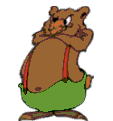 Then
the chief speaker, Grizzly Bear, rose. "Friends," he said
to the small animals and the insects, "You know very well how the
people hunt us on mountains and hills, even pursuing us into our dens.
Therefore, my brothers, we large animals have agreed to ask Him Who
Made Us to give our earth cold winters, colder than ever, so that the
people who hunt us cannot come into our dens and kill us and you! Large
animals, is this so?"
Then
the chief speaker, Grizzly Bear, rose. "Friends," he said
to the small animals and the insects, "You know very well how the
people hunt us on mountains and hills, even pursuing us into our dens.
Therefore, my brothers, we large animals have agreed to ask Him Who
Made Us to give our earth cold winters, colder than ever, so that the
people who hunt us cannot come into our dens and kill us and you! Large
animals, is this so?"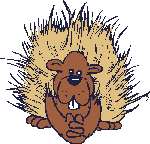 The
small animals did not reply at first. After they had been silent for
a while, Porcupine rose and said, "Friends, let me say a word or
two in response. Your strategy is very good for you, because you have
plenty of warm fur for the most severe cold. But look at these little
insects. They have no fur at all to warm them in winter. Moreover, how
can insects and small animals obtain food if winters are colder? Therefore
I say this: don't ask for more cold." Then he sat down.
The
small animals did not reply at first. After they had been silent for
a while, Porcupine rose and said, "Friends, let me say a word or
two in response. Your strategy is very good for you, because you have
plenty of warm fur for the most severe cold. But look at these little
insects. They have no fur at all to warm them in winter. Moreover, how
can insects and small animals obtain food if winters are colder? Therefore
I say this: don't ask for more cold." Then he sat down. The
wolverine (Gulo gulo) earned its place in North American folklore long
before north-country trappers and a few overzealous naturalists began
to spin tales of a beast of great ferocity, cunning, and extraordinary
strength. Indian mythology describes the wolverine as a trickster-hero,
and a link to the spirit world. Still, even today the wolverine remains
largely a mystery.
The
wolverine (Gulo gulo) earned its place in North American folklore long
before north-country trappers and a few overzealous naturalists began
to spin tales of a beast of great ferocity, cunning, and extraordinary
strength. Indian mythology describes the wolverine as a trickster-hero,
and a link to the spirit world. Still, even today the wolverine remains
largely a mystery.  Their
necks are larger than our heads, supporting tremendous jaw muscles that
can crush even the massive leg bones of moose. They have heavily muscled
legs, much larger in comparison to the leg muscles of other animals
similar in size. Some people say their strength is comparable to that
of a bear. Their semi-retractable claws (like a cat's claw, only much
larger), over one and a half inches long, are very sharp and light in
color. They use their claws for digging, climbing, and to capture and
kill their prey.
Their
necks are larger than our heads, supporting tremendous jaw muscles that
can crush even the massive leg bones of moose. They have heavily muscled
legs, much larger in comparison to the leg muscles of other animals
similar in size. Some people say their strength is comparable to that
of a bear. Their semi-retractable claws (like a cat's claw, only much
larger), over one and a half inches long, are very sharp and light in
color. They use their claws for digging, climbing, and to capture and
kill their prey.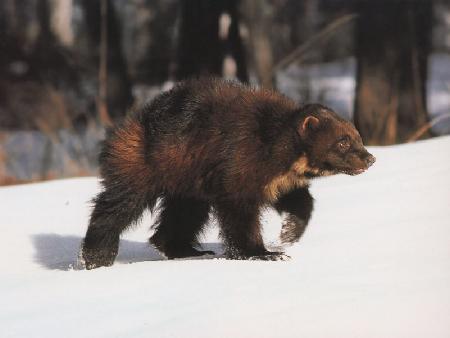 The
mother wolverine will nurse her kits, taking short trips to caches to
eat. Later she will bring food to her kits. In a few weeks, she will
take her kits on short hunting trips and they will watch her to learn
to hunt. Within a year or two, the kits will move into their own territories
and lead solitary lives. Wolverine territories vary in size from a female's
range of about a hundred fifty (150) square miles to a male's range
well over three hundred (300) square miles. Several female's may have
their territories within the territory of a male. Male territories do
not usually overlap. All wolverines mark their territory using specialized
scent glands and urine. This tells other wolverines that the area has
been taken.
The
mother wolverine will nurse her kits, taking short trips to caches to
eat. Later she will bring food to her kits. In a few weeks, she will
take her kits on short hunting trips and they will watch her to learn
to hunt. Within a year or two, the kits will move into their own territories
and lead solitary lives. Wolverine territories vary in size from a female's
range of about a hundred fifty (150) square miles to a male's range
well over three hundred (300) square miles. Several female's may have
their territories within the territory of a male. Male territories do
not usually overlap. All wolverines mark their territory using specialized
scent glands and urine. This tells other wolverines that the area has
been taken.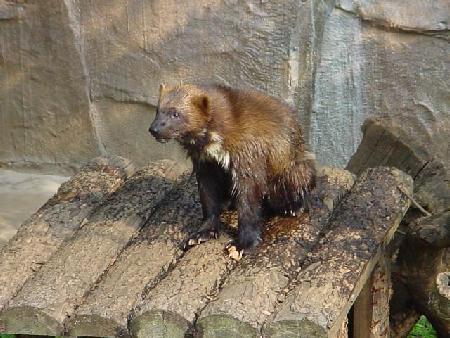 Wolverines
always cache any extra meat to be eaten later when food is scarce. Foxes
and other animals also cache their food. They depend on cached food
in the winter when food is scarce.
Wolverines
always cache any extra meat to be eaten later when food is scarce. Foxes
and other animals also cache their food. They depend on cached food
in the winter when food is scarce.